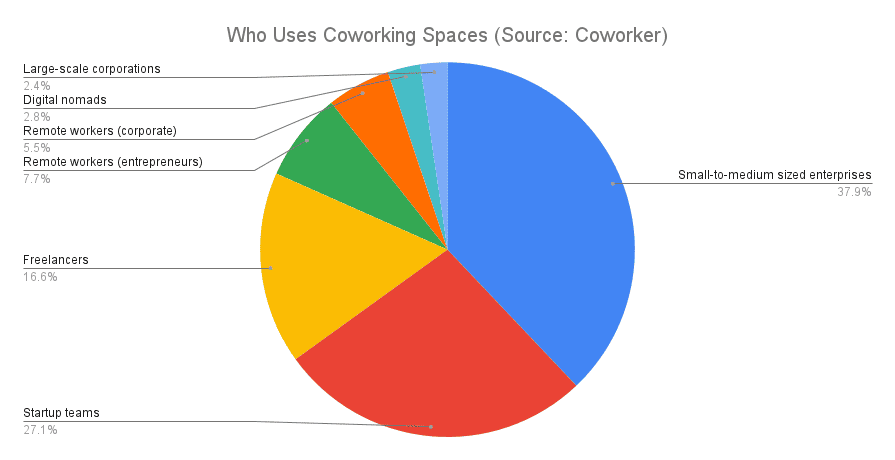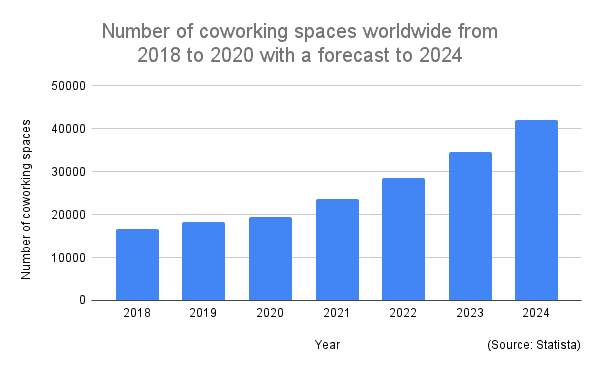
Learn about the state of coworking in 2024
Sunday February 25, 2024
Book a tour of 42workspace Join our community
It’s no secret that the traditional 9-to-5 work grind is slowly but surely becoming a thing of the past. In its place, a more flexible, collaborative way of working is on the rise – and it’s called coworking. This report will highlight some of Rotterdam’s coworking statistics as well as general information on the industry.
In 2024, Rotterdam stands out as a hub of coworking excellence, with a surge in popularity among professionals seeking flexible and inspiring work environments. The city’s coworking spaces offer a diverse array of options, catering to the needs of startups, freelancers, and established businesses alike. This trend reflects Rotterdam’s commitment to innovation and collaboration, making it a prime destination for those looking to thrive in a dynamic work setting.
DISCOVER MORE OF WHAT MATTERS TO YOU

Coworking is a work style that allows people to come together in a shared space to work on their projects, while also being able to collaborate and socialize with others in the same environment. Not only does coworking mean sharing communal space, but it also implies the sharing and common use of equipment, utilities, as well as refreshments.
The term coworking has evolved quite a lot over time, so the meaning of the word can be used in different contexts and is up to interpretation. However, in recent years, the above view of the word is the most popular one.
Coworking spaces offer a flexible and affordable alternative to traditional office space. They also provide a collaborative and creative environment that can benefit businesses and workers. Usually, coworking spaces operate through memberships and different types of subscriptions. You can choose from various options like a private office, shared office or a premium desk.
Considering all these factors, coworking spaces can lead to the natural creation of diverse communities. After all, the various members of coworking offices arrive in the space with one goal – to work productively, whether individually or collaboratively.

Coworking spaces and the communities they end up building attract a wide range of professionals. They are popular with freelancers, entrepreneurs, and remote workers, the kind of professionals who are especially attracted by a flexible, affordable alternative to traditional office spaces.
But besides the previously mentioned independents going to coworking spaces, the practice has become way more popular even amongst organizations and business teams.
In the pie chart below we have visualised the most common membership demographics of coworking offices.

Coworking offices are most popular among small-to-medium sized enterprises, or in other words, organizations and businesses with small or medium teams. These make up 37.93% of the entire population of coworking users. In contrast, only about 2.35% of the coworking population consists of large-scale corporations.
Meanwhile, the second largest group that uses coworking spaces is startup teams, making up 27.12% of the users. This is followed by freelancers and remote workers, at 16.61% and 13.17% respectively.
The groups making up the lowest percentages of coworking space users are digital nomads, 2.82%, and large-scale corporations. While big companies oftentimes rent their own office space, digital nomads are likely to use cheaper alternatives such as cafés & libraries, and they represent an overall lower share of the workforce.

Considering their increasing popularity, one has to wonder how coworking spaces make their income.
The number one revenue for coworking spaces comes from renting out workspaces like desks, making up around 61% of their whole income. This works through memberships, meaning that companies or individuals can sign up to use the space on a monthly or annual basis. The membership fees cover the costs of maintaining the space and provide a steady stream of revenue for the business.
Besides that, coworking spaces also offer the possibility to rent out meeting rooms and event spaces, each of which brings approximately 10% of the revenue. This can be a great option for startup groups and SMEs.
Finally, many coworking spaces host events, workshops, and other gatherings. These events can be private or open to the public, but they’re typically a great way to bring in some additional revenue of about 5% of the total. Additionally, food and beverage services provide another 5% of the revenue.
These are the most common revenue streams for coworking spaces. As the demand for flexible work continues to grow, we expect to see even more of these spaces popping up in the years to come. As an example, our very own 42workspace makes its income in a similar manner.

Rotterdam’s coworking statistics seem to forecast a growing trend for coworking spaces. One reason for this could be the recent startups boom around the world, especially tech startups. This growth in entrepreneurship is increasing the demand for coworking spaces. Whether this is surprising or not, coworking spaces can thus be considered the next big investment opportunity.
However, a recent survey has shown that as of 2019, only 43% of existing coworking spaces are profitable, meaning that the majority of them are still operating at a loss. The rise & fall of the largest coworking space in the world has many lessons to be learned in this regard.
Though this may sound discouraging, consider the fact that the coworking industry is young and is therefore rapidly developing.

The coworking movement has been gathering steam for years now, and it shows no signs of slowing down. A recent report has been able to project a forecast on the number of coworking spaces in the world up until 2024. The data demonstrates that there is indeed a consistent growth in the development and expansion of coworking businesses.

From 2018 to 2024, within just six years, the number of coworking spaces worldwide is expected to almost triple.This growth is being driven by a number of factors, including the rise of the freelance economy, the popularity of remote work, and the need for more flexible office space options. As more people embrace coworking, we’re likely to see even more growth in the coming years.
So what does this all mean for the future of work? It’s hard to say with certainty, but it seems clear that coworking is here to stay. As the coworking movement continues to grow, we can expect to see more people working in flexible, collaborative environments. Read our guide to know more about the statistics of coworking facilities.

Let’s talk about costs. In this chapter, we outline find information on the average costs of starting a coworking space in the Netherlands:
The first thing to consider when starting a coworking business is the location and cost of the rent. You’ll need to find a space that’s large enough to accommodate your needs, and that can be expensive. In the Netherlands, the average between the four Randstad cities was ~180 euros per square metre per month in 2020. Crucially, the price also depends on the neighborhood and type of community you’re aiming for.
Once you find an appropriate location, you also have to factor in energy costs. For gas and heating, businesses pay between €5-10 per square meter per year. For electricity, the average costs for an office space is €10 per square meter per year. Summed up, you should set aside around €20 per square meter per year for energy costs.
You’ll also need to factor in the cost of furniture and office equipment. You can get by with used items if you’re on a budget, but you’ll need to make sure they’re in good condition. Generally, furniture pieces under €100 each can be found at Ikea, second-hand shops, or similar affordable stores.
Finally, you’ll need to think about whether you’ll be leading the business as a one-person show or whether you’ll have a team. Though the latter option will cost you money, it can prove to be very promising. Overall, a conservsative estimate for hiring a community manager, an administrative manager, and an operations manager would cost about €10.000 per month in the Netherlands.
One more thing to consider is marketing and advertising. You’ll need to get the word out about your business, and that can become costly. However, don’t spend too much on it, especially at the beginning. Instead, use social media & inbound marketing as much as possible, as these make up the most affordable methods of marketing.
All told, you could be looking at several thousand euros just to get started. But with proper business planning and enough passion, it can be worth it.

The coworking industry is booming. There are a six main factors that account for this explosive growth.
First, the traditional 9-to-5 work day is no longer the norm. After the pandemic,with the rise of the gig economy and the proliferation of remote work, more and more people are working unconventional hours. This means they need a flexible, affordable place to work outside of their homes.
Second, coworking spaces provide a much-needed sense of community for freelancers, entrepreneurs, and other independent workers.
These workers often feel isolated and lonely when working from home, so they gravitate to coworking spaces where they can socialize and collaborate with other like-minded individuals.
With a wider diversity of people around you to bounce ideas off of and connect with, as well as a space designed in unique new ways, coworking spaces are simply more fun than working from home or a traditional office.
They’re often designed to be stimulating and inspiring, with plenty of amenities like coffee shops, lounges, game rooms, and a pleasant interior. This makes them ideal for people who want to enjoy their work environment as well as their work itself.
Lastly, these spaces offer ergonomic workstations, furnishings, and natural light, making it comfortable to work.

Coworking spaces are a new form of working style that, in many ways, represents the future of flexible spaces. They bring together people from different industries and companies in a shared working space, providing at the same time flexible solutions to office space needs.
Starting a coworking space can be costly, but the revenue streams can be diverse, ranging from renting of spaces to workshops or food sales. Even though the majority of these spaces are not yet profitable, the current and projected increase in coworking spaces highlights the need for such flexible spaces. This is especially true for the groups who currently most use them: small-medium sized businesses, freelancers and startups. These groups might indeed have the most to gain from coworking spaces because of the affordability and flexibility of coworking spaces, the thought-out design and adaptability, as well as the much-needed networking and community-building opportunities.
Continue reading by learning more about the state of coworking in our comprehensive report.